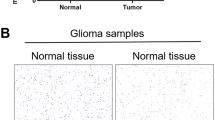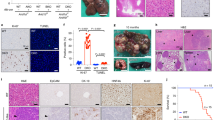Abstract
The INK4a/ARF locus, encoding two tumor suppressor proteins, p16INK4a and p14ARF (ARF), plays key roles in many cellular processes including cell proliferation, apoptosis, cellular senescence and differentiation. Inactivation of INK4a/ARF is one of the most frequent events during human cancer development. Although p16INK4a is a critical component in retinoblastoma protein (Rb)-mediated growth regulatory pathway, p14ARF plays a pivotal role in the activation of p53 upon oncogenic stress signals. A body of evidence indicates that ARF also possesses growth suppression functions independent of p53, the mechanism of which is not well understood. We have recently shown that MDM2 interacts with Rb and promotes proteasome-dependent Rb degradation. In this study, we show that ARF disrupts MDM2–Rb interaction resulting in Rb accumulation. Wild-type ARF, but not ARF mutant defective in MDM2 interaction, stabilizes Rb and inhibits colony foci formation independent of p53. In addition, ablation of Rb impairs ARF function in growth suppression. Thus, this study demonstrates that ARF plays a direct role in regulation of Rb and suggests that inactivation of ARF may lead to defects in both p53 and Rb pathways in human cancer development.
This is a preview of subscription content, access via your institution
Access options
Subscribe to this journal
Receive 50 print issues and online access
$259.00 per year
only $5.18 per issue
Buy this article
- Purchase on Springer Link
- Instant access to full article PDF
Prices may be subject to local taxes which are calculated during checkout





Similar content being viewed by others
References
Berezutskaya E, Yu B, Morozov A, Raychaudhuri P, Bagchi S . (1997). Differential regulation of the pocket domains of the retinoblastoma family proteins by the HPV16 E7 oncoprotein. Cell Growth Differ 8: 1277–1286.
Bothner B, Lewis WS, DiGiammarino EL, Weber JD, Bothner SJ, Kriwacki RW . (2001). Defining the molecular basis of Arf and Hdm2 interactions. J Mol Biol 314: 263–277.
Boyer SN, Wazer DE, Band V . (1996). E7 protein of human papilloma virus-16 induces degradation of retinoblastoma protein through the ubiquitin–proteasome pathway. Cancer Res 56: 4620–4624.
Burns JC, Friedmann T, Driever W, Burrascano M, Yee JK . (1993). Vesicular stomatitis virus G glycoprotein pseudotyped retroviral vectors: concentration to very high titer and efficient gene transfer into mammalian and nonmammalian cells. Proc Natl Acad Sci USA 90: 8033–8037.
Carnero A, Hudson JD, Price CM, Beach DH . (2000). p16INK4A and p19ARF act in overlapping pathways in cellular immortalization. Nat Cell Biol 2: 148–155.
Chan HM, Krstic-Demonacos M, Smith L, Demonacos C, La Thangue NB . (2001). Acetylation control of the retinoblastoma tumour-suppressor protein. Nat Cell Biol 3: 667–674.
Christophorou MA, Ringshausen I, Finch AJ, Swigart LB, Evan GI . (2006). The pathological response to DNA damage does not contribute to p53-mediated tumour suppression. Nature 443: 214–217.
Dannenberg JH, van Rossum A, Schuijff L, te Riele H . (2000). Ablation of the retinoblastoma gene family deregulates G(1) control causing immortalization and increased cell turnover under growth-restricting conditions. Genes Dev 14: 3051–3064.
Dias SS, Milne DM, Meek DW . (2006). c-Abl phosphorylates Hdm2 at tyrosine 276 in response to DNA damage and regulates interaction with ARF. Oncogene 25: 6666–6671.
Eischen CM, Weber JD, Roussel MF, Sherr CJ, Cleveland JL . (1999). Disruption of the ARF-Mdm2-p53 tumor suppressor pathway in Myc-induced lymphomagenesis. Genes Dev 13: 2658–2669.
Goldberg Z, Vogt Sionov R, Berger M, Zwang Y, Perets R, Van Etten RA et al. (2002). Tyrosine phosphorylation of Mdm2 by c-Abl: implications for p53 regulation. EMBO J 21: 3715–3727.
Groth A, Weber JD, Willumsen BM, Sherr CJ, Roussel MF . (2000). Oncogenic Ras induces p19ARF and growth arrest in mouse embryo fibroblasts lacking p21Cip1 and p27Kip1 without activating cyclin D-dependent kinases. J Biol Chem 275: 27473–27480.
Hainaut P, Soussi T, Shomer B, Hollstein M, Greenblatt M, Hovig E et al. (1997). Database of p53 gene somatic mutations in human tumors and cell lines: updated compilation and future prospects. Nucleic Acids Res 25: 151–157.
Hall M, Peters G . (1996). Genetic alterations of cyclins, cyclin-dependent kinases, and Cdk inhibitors in human cancer. Adv Cancer Res 68: 67–108.
Higashitsuji H, Itoh K, Nagao T, Dawson S, Nonoguchi K, Kido T et al. (2000). Reduced stability of retinoblastoma protein by gankyrin, an oncogenic ankyrin-repeat protein overexpressed in hepatomas. Nat Med 6: 96–99.
Honda R, Yasuda H . (1999). Association of p19(ARF) with Mdm2 inhibits ubiquitin ligase activity of Mdm2 for tumor suppressor p53. EMBO J 18: 22–27.
Iida S, Akiyama Y, Nakajima T, Ichikawa W, Nihei Z, Sugihara K et al. (2000). Alterations and hypermethylation of the p14(ARF) gene in gastric cancer. Int J Cancer 87: 654–658.
Kamijo T, Weber JD, Zambetti G, Zindy F, Roussel MF, Sherr CJ . (1998). Functional and physical interactions of the ARF tumor suppressor with p53 and Mdm2. Proc Natl Acad Sci USA 95: 8292–8297.
Kamijo T, Zindy F, Roussel MF, Quelle DE, Downing JR, Ashmun RA et al. (1997). Tumor suppression at the mouse INK4a locus mediated by the alternative reading frame product p19ARF. Cell 91: 649–659.
Kumar R, Sauroja I, Punnonen K, Jansen C, Hemminki K . (1998). Selective deletion of exon 1 beta of the p19ARF gene in metastatic melanoma cell lines. Genes Chromosomes Cancer 23: 273–277.
Leduc C, Claverie P, Eymin B, Col E, Khochbin S, Brambilla E et al. (2006). p14(ARF) promotes RB accumulation through inhibition of its Tip60-dependent acetylation. Oncogene 25: 4147–4154.
Llanos S, Clark PA, Rowe J, Peters G . (2001). Stabilization of p53 by p14ARF without relocation of MDM2 to the nucleolus. Nat Cell Biol 3: 445–452.
Midgley CA, Desterro JM, Saville MK, Howard S, Sparks A, Hay RT et al. (2000). An N-terminal p14ARF peptide blocks Mdm2-dependent ubiquitination in vitro and can activate p53 in vivo. Oncogene 19: 2312–2323.
Modestou M, Puig-Antich V, Korgaonkar C, Eapen A, Quelle DE . (2001). The alternative reading frame tumor suppressor inhibits growth through p21-dependent and p21-independent pathways. Cancer Res 61: 3145–3150.
Momand J, Jung D, Wilczynski S, Niland J . (1998). The MDM2 gene amplification database. Nucleic Acids Res 26: 3453–3459.
Nguyen DX, Baglia LA, Huang SM, Baker CM, McCance DJ . (2004). Acetylation regulates the differentiation-specific functions of the retinoblastoma protein. EMBO J 23: 1609–1618.
Pan W, Datta A, Adami GR, Raychaudhuri P, Bagchi S . (2003). P19ARF inhibits the functions of the HPV16 E7 oncoprotein. Oncogene 22: 5496–5503.
Pomerantz J, Schreiber-Agus N, Liegeois NJ, Silverman A, Alland L, Chin L et al. (1998). The Ink4a tumor suppressor gene product, p19Arf, interacts with MDM2 and neutralizes MDM2's inhibition of p53. Cell 92: 713–723.
Quelle DE, Cheng M, Ashmun RA, Sherr CJ . (1997). Cancer-associated mutations at the INK4a locus cancel cell cycle arrest by p16INK4a but not by the alternative reading frame protein p19ARF. Proc Natl Acad Sci USA 94: 669–673.
Randerson-Moor JA, Harland M, Williams S, Cuthbert-Heavens D, Sheridan E, Aveyard J et al. (2001). A germline deletion of p14(ARF) but not CDKN2A in a melanoma–neural system tumour syndrome family. Hum Mol Genet 10: 55–62.
Rizos H, Puig S, Badenas C, Malvehy J, Darmanian AP, Jimenez L et al. (2001). A melanoma-associated germline mutation in exon 1beta inactivates p14ARF. Oncogene 20: 5543–5547.
Sage J, Mulligan GJ, Attardi LD, Miller A, Chen S, Williams B et al. (2000). Targeted disruption of the three Rb-related genes leads to loss of G(1) control and immortalization. Genes Dev 14: 3037–3050.
Sdek P, Ying H, Chang DL, Qiu W, Zheng H, Touitou R et al. (2005). MDM2 promotes proteasome-dependent ubiquitin-independent degradation of retinoblastoma protein. Mol Cell 20: 699–708.
Sdek P, Ying H, Zheng H, Margulis A, Tang X, Tian K et al. (2004). The central acidic domain of MDM2 is critical in inhibition of Rb-mediated suppression of E2F and cell growth. J Biol Chem 279: 53317–53322.
Serrano M . (2000). The INK4a/ARF locus in murine tumorigenesis. Carcinogenesis 21: 865–869.
Serrano M, Lee H, Chin L, Cordon-Cardo C, Beach D, DePinho RA . (1996). Role of the INK4a locus in tumor suppression and cell mortality. Cell 85: 27–37.
Sharpless NE, Ramsey MR, Balasubramanian P, Castrillon DH, DePinho RA . (2004). The differential impact of p16(INK4a) or p19(ARF) deficiency on cell growth and tumorigenesis. Oncogene 23: 379–385.
Sherr CJ . (2001). The INK4a/ARF network in tumour suppression. Nat Rev Mol Cell Biol 2: 731–737.
Sionov RV, Coen S, Goldberg Z, Berger M, Bercovich B, Ben-Neriah Y et al. (2001). c-Abl regulates p53 levels under normal and stress conditions by preventing its nuclear export and ubiquitination. Mol Cell Biol 21: 5869–5878.
Sionov RV, Moallem E, Berger M, Kazaz A, Gerlitz O, Ben-Neriah Y et al. (1999). c-Abl neutralizes the inhibitory effect of Mdm2 on p53. J Biol Chem 274: 8371–8374.
Stott FJ, Bates S, James MC, McConnell BB, Starborg M, Brookes S et al. (1998). The alternative product from the human CDKN2A locus, p14(ARF), participates in a regulatory feedback loop with p53 and MDM2. EMBO J 17: 5001–5014.
Sui G, Affar el B, Shi Y, Brignone C, Wall NR, Yin P et al. (2004). Yin Yang 1 is a negative regulator of p53. Cell 117: 859–872.
Tao W, Levine AJ . (1999). P19(ARF) stabilizes p53 by blocking nucleo-cytoplasmic shuttling of Mdm2. Proc Natl Acad Sci USA 96: 6937–6941.
Tsai KY, MacPherson D, Rubinson DA, Nikitin AY, Bronson R, Mercer KL et al. (2002). ARF mutation accelerates pituitary tumor development in Rb+/− mice. Proc Natl Acad Sci USA 99: 16865–16870.
Uchida C, Miwa S, Kitagawa K, Hattori T, Isobe T, Otani S et al. (2005). Enhanced Mdm2 activity inhibits pRB function via ubiquitin-dependent degradation. EMBO J 24: 160–169.
Viswanathan M, Tsuchida N, Shanmugam G . (2001). Selective deletion of p14(ARF) exon 1beta of the INK4a locus in oral squamous cell carcinomas of Indians. Oral Oncol 37: 341–344.
Wang C, Ivanov A, Chen L, Fredericks WJ, Seto E, Rauscher III FJ et al. (2005). MDM2 interaction with nuclear corepressor KAP1 contributes to p53 inactivation. EMBO J 24: 3279–3290.
Wang J, Sampath A, Raychaudhuri P, Bagchi S . (2001). Both Rb and E7 are regulated by the ubiquitin proteasome pathway in HPV-containing cervical tumor cells. Oncogene 20: 4740–4749.
Weber JD, Jeffers JR, Rehg JE, Randle DH, Lozano G, Roussel MF et al. (2000a). p53-independent functions of the p19(ARF) tumor suppressor. Genes Dev 14: 2358–2365.
Weber JD, Kuo ML, Bothner B, DiGiammarino EL, Kriwacki RW, Roussel MF et al. (2000b). Cooperative signals governing ARF–mdm2 interaction and nucleolar localization of the complex. Mol Cell Biol 20: 2517–2528.
Weber JD, Taylor LJ, Roussel MF, Sherr CJ, Bar-Sagi D . (1999). Nucleolar Arf sequesters Mdm2 and activates p53. Nat Cell Biol 1: 20–26.
Weinberg RA . (1995). The retinoblastoma protein and cell cycle control. Cell 81: 323–330.
Xiao ZX, Chen J, Levine AJ, Modjtahedi N, Xing J, Sellers WR et al. (1995). Interaction between the retinoblastoma protein and the oncoprotein MDM2. Nature 375: 694–698.
Ying H, Xiao ZX . (2006). Targeting retinoblastoma protein for degradation by proteasomes. Cell Cycle 5: 506–508.
Zhang Y, Xiong Y . (1999). Mutations in human ARF exon 2 disrupt its nucleolar localization and impair its ability to block nuclear export of MDM2 and p53. Mol Cell 3: 579–591.
Zhang Y, Xiong Y, Yarbrough WG . (1998). ARF promotes MDM2 degradation and stabilizes p53: ARF-INK4a locus deletion impairs both the Rb and p53 tumor suppression pathways. Cell 92: 725–734.
Acknowledgements
We thank Drs Ronald A DePinho, Scott Lowe and Yanping Zhang for plasmids and viruses. We are grateful to Drs Charles Sherr and Guillermina Lozano for MEF cells. We thank Yian Xiao for critical reading of the manuscript. This work was supported by the Karin Grunebaum Cancer Research Fellowship and the Boston University Graduate Student Research Fellowship (to DLC) and NIH grants (to ZX Xiao).
Author information
Authors and Affiliations
Corresponding author
Rights and permissions
About this article
Cite this article
Chang, D., Qiu, W., Ying, H. et al. ARF promotes accumulation of retinoblastoma protein through inhibition of MDM2. Oncogene 26, 4627–4634 (2007). https://doi.org/10.1038/sj.onc.1210254
Received:
Revised:
Accepted:
Published:
Issue Date:
DOI: https://doi.org/10.1038/sj.onc.1210254



